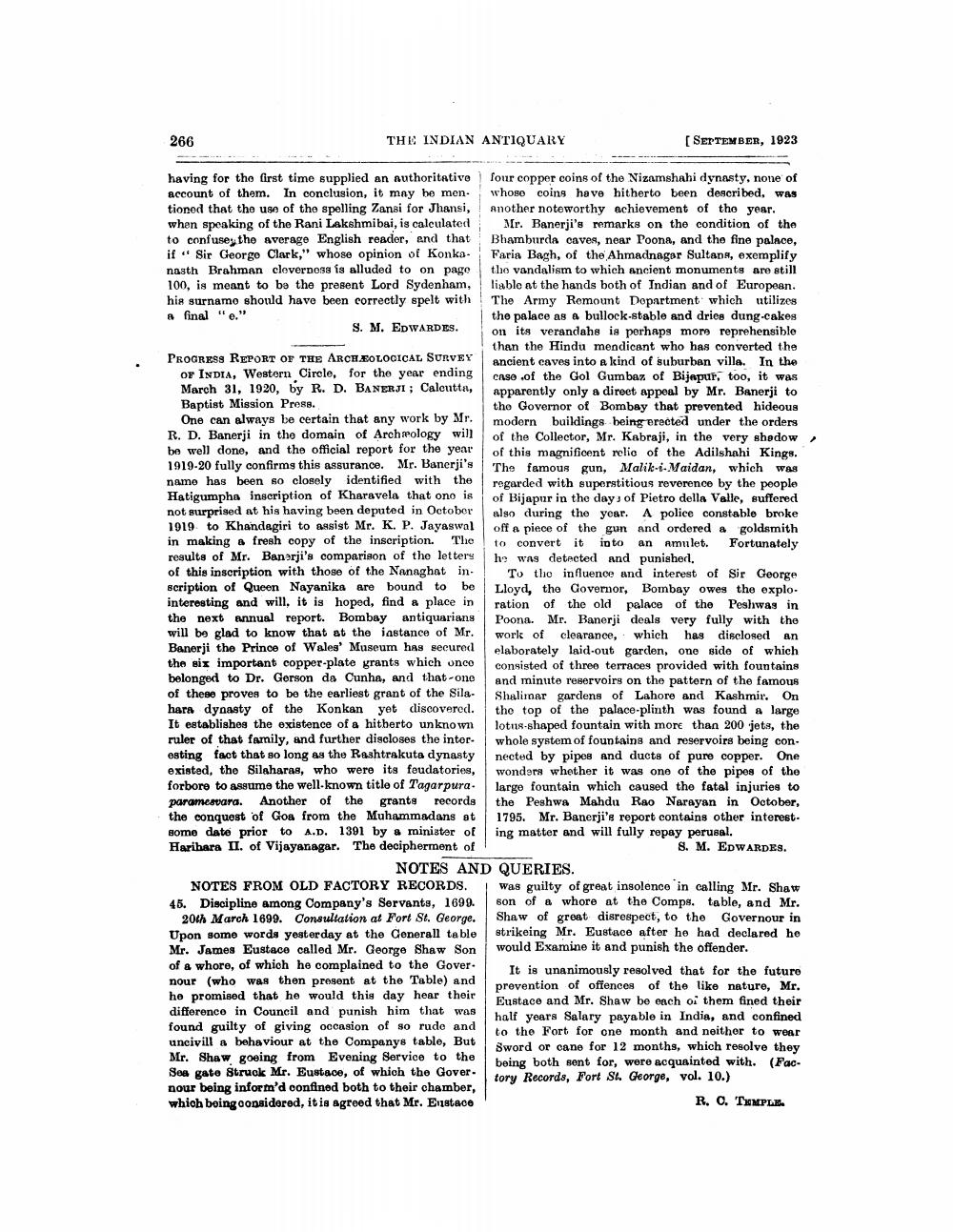________________
266
THE INDIAN ANTIQUARY
having for the first time supplied an authoritative account of them. In conclusion, it may be men. tioned that the use of the spelling Zansi for Jhansi, when speaking of the Rani Lakshmibai, is calculated to confuse the average English reader, and that if Sir George Clark," whose opinion of Konkanasth Brahman cleverness is alluded to on page 100, is meant to be the present Lord Sydenham, his surname should have been correctly spelt with a final "e." S. M. EDWARDES.
[SEPTEMBER, 1923
four copper coins of the Nizamshahi dynasty, none of whose coins have hitherto been described, was another noteworthy achievement of the year.
Mr. Banerji's remarks on the condition of the Bhamburda caves, near Poona, and the fine palace, Faria Bagh, of the Ahmadnagar Sultans, exemplify the vandalism to which ancient monuments are still liable at the hands both of Indian and of European. The Army Remount Department which utilizes the palace as a bullock-stable and dries dung-cakes on its verandahs is perhaps more reprehensible than the Hindu mendicant who has converted the ancient caves into a kind of suburban villa. In the case of the Gol Gumbaz of Bijapur, too, it was apparently only a direct appeal by Mr. Banerji to the Governor of Bombay that prevented hideous modern buildings being erected under the orders of the Collector, Mr. Kabraji, in the very shadow of this magnificent relic of the Adilshahi Kings. The famous gun, Malik-i-Maidan, which was regarded with superstitious reverence by the people of Bijapur in the day of Pietro della Valle, suffered also during the year. A police constable broke off a piece of the gun and ordered a goldsmith to convert it in to an amulet. Fortunately he was detected and punisherl.
To the influence and interest of Sir George Lloyd, the Governor, Bombay owes the explo ration of the old palace of the Peshwas in Poona. Mr. Banerji deals very fully with the work of clearance, which has disclosed an elaborately laid-out garden, one side of which consisted of three terraces provided with fountains and minute reservoirs on the pattern of the famous Shalimar gardens of Lahore and Kashmir. On the top of the palace-plinth was found a large lotus-shaped fountain with more than 200 jets, the whole system of fountains and reservoirs being connected by pipes and ducts of pure copper. One wonders whether it was one of the pipes of the large fountain which caused the fatal injuries to the Peshwa Mahdu Rao Narayan in October, 1795. Mr. Banerji's report contains other interest. ing matter and will fully repay perusal.
8. M. EDWARDES.
PROGRESS REPORT OF THE ARCHEOLOGICAL SURVEY OF INDIA, Western Circle, for the year ending March 31, 1920, by R. D. BANERJI; Calcutta, Baptist Mission Press.
One can always be certain that any work by Mr. R. D. Banerji in the domain of Archæology will be well done, and the official report for the year 1919-20 fully confirms this assurance. Mr. Banerji's name has been so closely identified with the Hatigumpha inscription of Kharavela that ono is not surprised at his having been deputed in October 1919 to Khandagiri to assist Mr. K. P. Jayaswal in making a fresh copy of the inscription. The results of Mr. Banerji's comparison of the letters of this inscription with those of the Nanaghat inscription of Queen Nayanika are bound to be interesting and will, it is hoped, find a place in the next annual report. Bombay antiquarians will be glad to know that at the instance of Mr. Banerji the Prince of Wales' Museum has secured the six important copper-plate grants which once belonged to Dr. Gerson da Cunha, and that-one of these proves to be the earliest grant of the Silahara dynasty of the Konkan yet discovered. It establishes the existence of a hitherto unknown ruler of that family, and further discloses the interesting fact that so long as the Rashtrakuta dynasty existed, the Silaharas, who were its feudatories, forbore to assume the well-known title of Tagarpuraparamesvara. Another of the grants records. the conquest of Goa from the Muhammadans at some date prior to A.D. 1391 by a minister of Harihara II. of Vijayanagar. The decipherment of NOTES AND NOTES FROM OLD FACTORY RECORDS. 45. Discipline among Company's Servants, 1699. 20th March 1699. Consultation at Fort St. George. Upon some words yesterday at the Generall table Mr. James Eustace called Mr. George Shaw Son of a whore, of which he complained to the Gover. nour (who was then present at the Table) and he promised that he would this day hear their difference in Council and punish him that was found guilty of giving occasion of so rude and uncivill a behaviour at the Companys table, But Mr. Shaw goeing from Evening Service to the Sea gate Struck Mr. Eustace, of which the Governour being inform'd confined both to their chamber, which being considered, it is agreed that Mr. Eustace
QUERIES.
was guilty of great insolence in calling Mr. Shaw son of a whore at the Comps. table, and Mr. Shaw of great disrespect, to the Governour in strikeing Mr. Eustace after he had declared he would Examine it and punish the offender.
It is unanimously resolved that for the future prevention of offences of the like nature, Mr. Eustace and Mr. Shaw be each of them fined their half years Salary payable in India, and confined to the Fort for one month and neither to wear Sword or cane for 12 months, which resolve they being both sent for, were acquainted with. (Factory Records, Fort St. George, vol. 10.)
R. C. TEMPLE.




